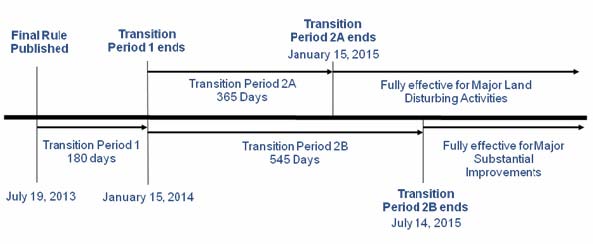The District of Columbia's Implementation of Stormwater Management Regulations Enters Second Transition Phase
HIGHLIGHTS:
- During the second transition period for the implementation of the District's new Stormwater Management Regulations, certain regulated projects may qualify for exemptions from certain stormwater retention requirements.
- The terms of the second transition period are complex and planners may have to alter their development schedules to take advantage of the exemptions provided.
The District Department of the Environment (DDOE) concluded the first transition period for the implementation of its new Stormwater Management Regulations on Jan.15, 2014. With the conclusion of the first transition period, qualifying regulated projects can no longer be grandfathered under the previous regulatory regime. However, the new Stormwater Management Regulations will not be fully implemented for at least one more year, and during the second transition period, many types of regulated projects may be exempted from certain stormwater retention requirements. Stormwater management is an issue of growing concern nationwide, and DDOE's implementation of the most stringent stormwater retention requirements in the country could blaze the trail for other jurisdictions to follow suit.
Summary of D.C.'s Stormwater Management Regulations
The Stormwater Management Regulations were enacted on July 19, 2013, as part of DDOE's rulemaking on Stormwater Management, and Soil Erosion and Sediment Control.1 Under the Stormwater Management Regulations, two types of regulated projects are required to retain substantial volumes of stormwater:
- Major Land Disturbing Activities. Sites that disturb 5,000 square feet or more of land area must retain stormwater volumes attributable to a 1.2 inch rainfall.2
- Major Substantial Improvement Activities. Renovation projects in existing structures with a combined footprint of 5,000 square feet for which the project costs exceed 50 percent of the structure's assessed value must retain stormwater volumes attributable to a 0.8 inch rainfall.3
At least half of a regulated project's required Stormwater Retention Volume (SWRv) must be retained on-site using a combination of approved best management practices (BMPs).4 The remaining volume may be retained off-site via payment of an in-lieu fee to DDOE or the purchase of Stormwater Retention Credits (SRCs) through DDOE's new SRC Trading Program.5
Terms of the Second D.C. Stormwater Management Transition Period
Other provisions contained in the rulemaking that pertain to soil erosion and sediment control became effective immediately upon their enactment. However, the Stormwater Management Regulations are being implemented over a two-year multi-phase transition as follows:
The second transition period will continue for 365 days until Jan.15, 2015, for Major Land Disturbing Activities and for 545 days until July 14, 2015, for Major Substantial Improvement Activities.6 During this period, qualifying projects will be exempted from the requirement to retain at least half of their applicable SWRv on-site, and may satisfy their entire retention requirement via payment of the in-lieu fee or purchase of SRCs. Qualifying projects include:
- regulated projects that submit a stormwater management plan (SWMP) as part of a complete building permit application during the second transition period7
- regulated projects that are subject to a valid, unexpired "advanced design" that has been submitted to the appropriate regulatory authority during the second transition period8; an advanced design is defined to include:
- a stage 2 planned unit development application submitted to the District Zoning Commission
- an application for design review under the Capitol Gateway Overlay District submitted to the District Zoning Commission
- a final design submission to the National Capital Planning Commission9
- multi-phased regulated projects for which all stormwater retention infrastructure and BMPs have been installed in compliance with a DDOE-approved SWMP during the second transition period10
Additionally, regulated projects that applied for certain regulatory approvals prior to the end of the second transition period are eligible to apply to DDOE for relief from extraordinarily difficult site conditions.11 Eligible regulatory approvals include:
- a concept review by the Historic Preservation Review Board
- a concept review by the Commission on Fine Arts
- a preliminary or final design submission by the National Capital Planning Commission
- a variance or special exception from the Board of Zoning Adjustment
- a large tract review by the D.C. Office of Planning
In order to be granted this form of relief, a regulated project must demonstrate that installation of the necessary BMPs would conflict with the terms of one of these valid, unexpired regulatory approvals. Upon demonstrating such a conflict to DDOE, the regulated project may be exempted from the minimum on-site SWRv requirement, such that it may retain more than half, and possibly all, of its applicable SWRv through payment of the in-lieu fee or purchase of SRCs.12
D.C. Development Projects Facing Unintended Hurdles
As the most stringent stormwater controls in the country, the ability of regulated projects to successfully adapt to the Stormwater Management Regulations could have direct implications for the adoption of similar regulations in other jurisdictions. Six months after their enactment, the Stormwater Management Regulations continue to pose significant hurdles for new development projects in the District. The multi-phased transition that DDOE has established was intended to ease this burden for certain regulated projects to some degree; however, the terms of this transition are complex. As a result, planners will have to carefully consider the new Stormwater Management Regulations in order to understand what stormwater retention requirements will apply to their projects and may have to alter their development schedules in order to apply for qualifying regulatory approvals on a timely basis.
Notes
1See DDOE, Notice of Final Rulemaking on Stormwater Management, and Soil Erosion and Sediment Control, 60 D.C. Reg. 10,640 (July 19, 2013) (hereinafter, Stormwater Rules).
2See Stormwater Rules § 520.3.
3See Stormwater Rules § 522.4.
4See Stormwater Rules §§ 520.4, 522.5. For more information regarding the approved best management practices, see Chapter 3 of the DDOE Stormwater Management Guidebook.
5See Stormwater Rules § 527.
6See Stormwater Rules § 552.
7See Stormwater Rules § 552.2(b).
8See Stormwater Rules § 552.2(c).
9See Stormwater Rules § 599.1.
10See Stormwater Rules § 552.2(d).
11See Stormwater Rules § 526.
12See Stormwater Rules § 526.3.

